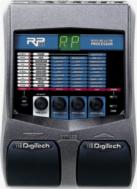DigiTech RP150 Modeling Guitar Processor
![]()
![]()
![]()
![]()
![]()
![]()
![]()
![]()

Honesty bids me say that had I been charged with designing a guitar effect that cranked everything up to ten and included every feature even tangentially related to playing a guitar through a box, I wouldn’t have come up with half the stuff in the RP150. Elegantly structured and flawless in its performance, the RP150 is a roomful of effects in a single pedal and a trained monkey to run it.
Beyond its high-end features and numerous additional gadgets, the effects available through the RP150 sound superb – by no means a common condition amongst effects pedals. In shopping around for something to make guitar noises more interesting, I tried several pedals that cost a lot more than the RP150 and sounded a good deal less sophisticated.
…and one that caught fire, which I won’t get into here.
The RP150 comes with fifty preset effects, ranging from the subtle to the truly obnoxious. Every one is a joy to play – not all of them probably need to be played in public.
As with most of the current generation of modeling effects, you can reprogram one or all of the effects offered by the RP150, fine tuning its existing sounds or wiping its brain and starting from scratch, as the mood suits you. Having said this, it’s worth noting that the original fifty present effects are duplicated in firmware, such that they’ll still be available even if you redesign every noise the pedal knows how to make.
Previous generations of modeling effects devices, while technically programmable, suffered from user interfaces that typically consisted of one button, two knobs and a handful of LEDs. Programming them was not dissimilar to trying to teach fruit to bark. The RP150 includes such a user interface, but you’ll never have to use it.
The RP150 also includes a USB interface. Plug it into a computer, download its free X-Edit software from the DigiTech web page and you can reprogram its sounds with an intuitive Windows or Macintosh editor application. Once you’ve configured the effects in the RP150 to your liking, you can save its sounds to your local hard drive and download your changes to the pedal.
The DigiTech web page includes a forum in which users of DigiTech’s pedals can swap effects, and a growing collection of downloadable contributed effects, should you want to see what everyone else is up to.
The combination of the R150’s generous library of models – the virtual devices, such as compression, flanging and chorus, that act upon the sound passing through the pedal – and a quick, elegant way to configure them makes getting precisely the sound you’re after easier than finding a liberal politician in hell.
Finally, I’d be remiss if I forgot to mention the RP150’s built-in drum machine. I’m not sure it really belongs in there, but it’s a very good drum machine, with a variety of patterns and better drum sounds than usually pop and thump and crash from dedicated drum boxes. You can easily waste hours playing against it.
It also should be noted that the RP150 is made in the United States, and perhaps more important, its manual appears to have been written there. As such, it’s intelligible from cover to cover without even a suggestion that it was translated into English from the original Japanese by someone who only spoke French.
Costing about a hundred dollars, the RP150 was the least expensive effects pedal I tried, and yet, it blew me away with a detonation far more explosive than that of pedals costing several times as much and occupying vastly more floor space.
DigiTech offers a number of higher-end pedals – the RP250 and RP350 feature additional models and generally more toys. While more toys are always better, even with no fixed spending limit and all day to decide, I found the RP150’s ease of use and small size made it as close to perfect as anything with a power connector is likely to get.